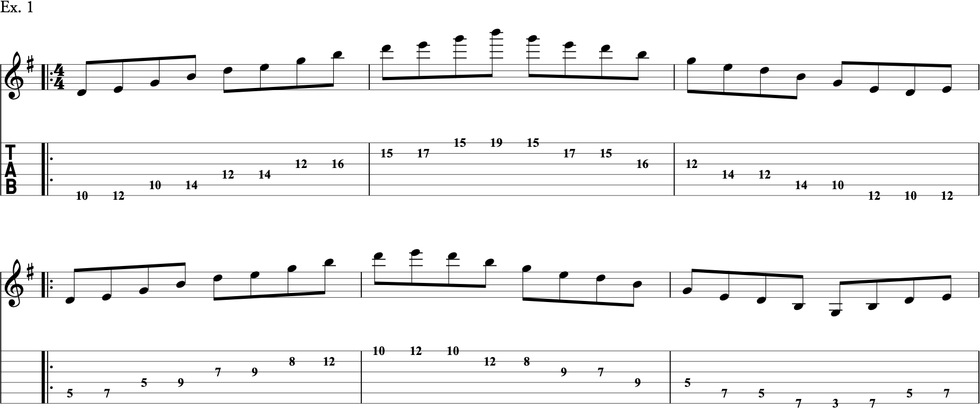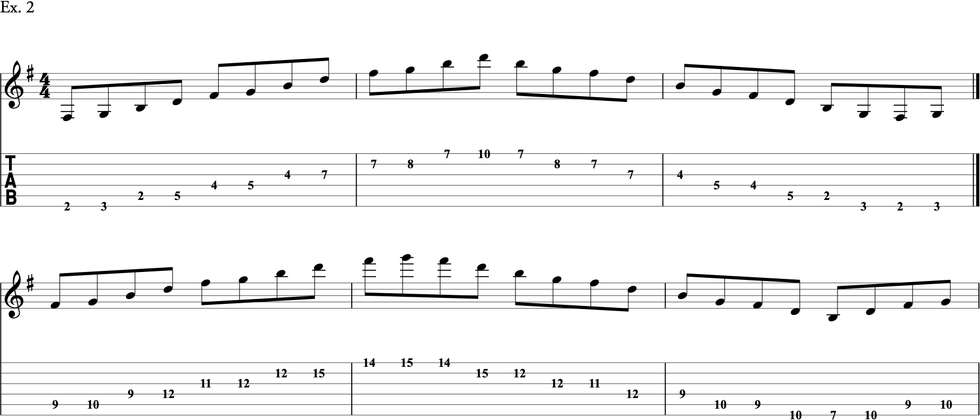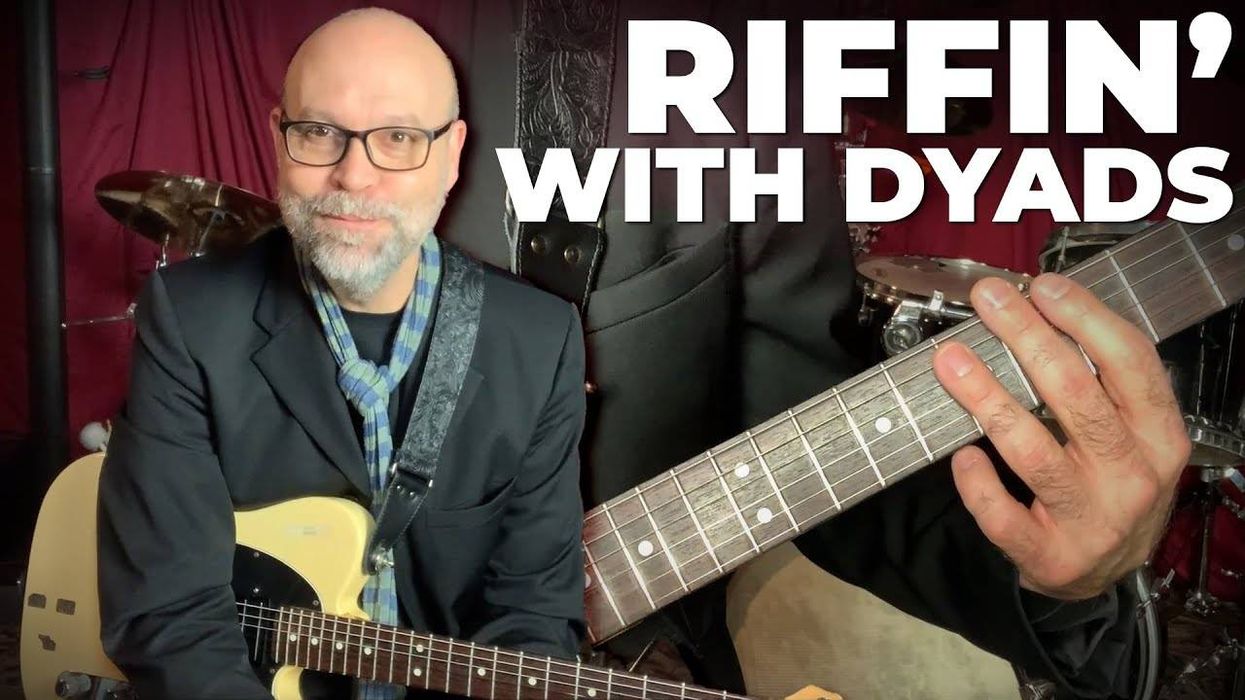Being a rock guitar teacher at Berklee, which is known primarily for jazz, is a bit like being the best dogsled racer in Hawaii. At the same time, it has its advantages. Mostly, I get a unique perspective on things simply because of where I am. There’s been a long-standing debate among musicians about the advantages and disadvantages of being musically educated. Some feel it’s essential, while others say it kills creativity. For me, it’s not what you know, but what you do with what you know.
Writing about rock improvisation is difficult. It’s not any one thing that makes it happen, but rather several elements converging. A great rock solo tells a story that gives you chills when you listen intently. It makes you feel. It’s visceral. My point is that learning scales and music theory will certainly broaden your horizons, but it might not help your rock improv.
When I think about what to practice, I think about balancing the head (the ability to intellectually understand what I’m doing), hands (the ability to physically execute the musical phrase I’m envisioning), and heart (creative expression). If I’m honest with myself, I usually find that one of those elements is a little out of balance with the others. That helps me decide what to practice next. If those elements are in balance, I’m playing at my current maximum potential, but I’ll know that there will always be room for improvement.
Most rock tunes tend to be harmonically simpler than most jazz tunes. For this reason, knowing a lot of different scales won’t necessarily make you a better rock improviser. So then the question is, what do you practice to become a better improviser? When your goal is to generate a fresh idea, very often this creates a kind of mental pressure that achieves the exact opposite of creative flow. One solution to this dilemma is to look for new ways to manipulate what you already know. It relieves the pressure of trying to be original and lets you experiment without worrying too much about results. If you like it, keep it. If not, throw it out. Simple as that.
Often, I find myself playing a game of “What if?” In other words, I’ll create a rule for myself, just to see what happens. Even though at first it seems like I’m artificially limiting myself, this approach actually brings an odd sense of freedom. Once you limit your options, the mind tends to think of a lot of possibilities within the set of rules. Many times I find things I might not have thought of, or paid any attention to.
If you try this approach, these things are guaranteed:
- You’ll come up with things you haven’t thought of.
- You won’t love every idea you come up with.
- You’ll see that there are tons of possibilities that should keep you practicing for a very long time.
Don’t Step in the Hole
Our first restriction is entirely rhythmic and the idea is simple: Don’t play on beat 1. You’ll find that you have to listen to your playing closely to understand where beat 1 actually is. In the beginning, it may sound stiff, but given a little time, you’ll be surprised at how many variations you can come up with. Check out Ex. 1 to see how I might use an easy A minor pentatonic (A–C–D–E–G) shape to practice this.
Click here for Ex. 1
In Ex. 2, we revisit this concept while using G Mixolydian (G–A–B-C–D–E–F) to play over a G7 chord. To make the line sound fluid, pay attention to the position shifts.
Click here for Ex. 2
Roots Are for Kids
It might be hard to fully embrace this idea, but the root isn’t the most important note in a chord. Let’s try leaving it out and see what happens. In Ex. 3, we have a short line based around A Mixolydian (A–B–C#–D–E–F#–G) that skirts around the root, but never actually includes it. Notice how each phrase or motif starts on a chord tone other than the root.
Click here for Ex. 3
Now, let’s move this no-root concept to the key of D. In Ex. 4, we avoid the root, but we also outline some diatonic chords. For example, we start off with a F#m7 arpeggio (F#–A–C#–E) that leads right into a C#m7 arpeggio (C#–E–G#–B). Note: G# is an “outside” note—i.e., one not found in the key of D—that adds flair. Remember, there aren’t any “wrong” notes, it’s all about how you use them and resolve the tension they create.
Click here for Ex. 4
Slippery Strings
Here’s another “practice rule” to explore: Try playing an entire solo without using the 2nd string. Why would you do this? Well, sometimes in the heat of a song, a string gives up the ghost but you still need to melt faces. If you develop the ability to be musical while dodging a string, you’ll be ready for this inevitable event. In Ex. 5, we’ll riff in G major without touching the 2nd string. We start with some diatonic sixths and then go into an E minor-inspired idea before ending with a descending scalar phrase.
Click here for Ex. 5
And of course, we can reverse that idea. In Ex. 6, the entire phrase involves only the 2nd string. This is played over a D7 sound, so we’ll stick to D Mixolydian (D–E–F#–G–A–B–C). Naturally, there’s a wealth of possibilities here. For example, try playing a melodic minor scale along the 4th string while experimenting with different combinations of glissando, hammer-on, and pull-off moves. Or what about some Dorian sounds on the 1st string? Bonus: Try playing such single-string exercises with a slide to work on your intonation.
Click here for Ex. 6
Target Practice
Even if you don’t know much music theory, the sound of target notes has already been etched into your psyche. Listen to Ex. 7 to hear a simple D–A–E progression and discover how easy it is to build a line by focusing on a few essential chord tones.
Simple, right? I’m hitting a D over the D chord, C# over the A, and G# over the E. We will treat these notes as somewhat of a starting point to create longer, more interesting lines. First, just try to play simple, melodic lines that hit our target notes on the downbeat. Soon you’ll find a mix of scales and arpeggios that will make you sound like you. For me, it comes out something like Ex. 8. I’ve also included some backing tracks below to practice bridging target notes in your improvisations.
Click here for Ex. 8
After practicing this idea for a while, you may find you’re able to weave the concept of bridging target notes into your soloing. It may seem calculated at first, but soon it will feel like you’re throwing a ball at something, rather than simply throwing a ball. Let’s expand on this idea with the next set of examples.
In Ex. 9, we have a Dm7–Bb7–Dm7–G9 progression. The harmony here is a little more expansive, but the concept still holds true. My target notes are A, Ab, A, and B, respectively.
The chords in this example are a tad jazzier than previous ones. For those of you that hate jazz, I apologize. Sort of. For the rest of you folks, let’s try to unpack the method behind this madness. For Dm7, I’m using the D Aeolian mode (D–E–F–G–A–Bb–C), and then going to a Bb Lydian b7 scale (Bb–C–D–E–F–G–Ab) for Bb7. Notice how these two scales differ by only one note—the A drops to Ab. Why is that important to know? Because it busts the myth that for every chord you must learn an entirely new scale. Also, you can use D Dorian (D–E–F–G–A–B–C) over the Dm7 and G Mixolydian (G–A–B–C–D–E–F) over the G7. And what do you know? Both scales contain exactly the same notes; the only thing that makes them different is their starting point.
Tip: When improvising, I find it easier to concentrate on the notes that need to change when the chords change (Ex. 10), rather than wiping the slate clean and mentally assigning a fresh scale to every chord. It’s a subtle conceptual difference, but once you start looking at progressions this way, it can transform your playing.
Click here for Ex. 10
Our final set of examples tackle a simpler route through a common progression. In Ex. 11, you can hear a D–A–Bm–G progression with a target-note line that goes F#, E, D, and B—the 3, 5, 5, and 3 of our four-chord progression.
In Ex. 12, I went for simple. I started with the four target pitches and just “walked” from one to the next. Though it’s the simplest of solutions, I’m always surprised by how good it sounds. Never overlook a melodic move just because it’s easy to execute.
Click here for Ex. 12
There’s no magic formula or method for selecting target notes. It’s simply about choosing a few notes that sound good with a given chord. Once you’ve explored these examples, come up with your own target notes and work out some licks that “walk” from one target note to the next. To do this effectively, you’ll need to experiment, and this requires time and patience. Pay attention to what you like and discard what you don’t, but keep at it.
What’s Next?
Learn all the licks in this lesson as written. Then focus on understanding how they work. Finally, invent your own variations of these licks using the same principles. You may be surprised how different yours will sound—and that’s a good thing.
Here are few other ideas to investigate:
- Imagine that when you’re playing guitar, you’re speaking. Think about the story you’re trying to tell, and what it would sound like if someone was telling the story in a way that’s engaging and exciting. Mimic the pacing of that with the phrases you play. Even if you’re the only one who knows the story that’s being told, your audience will understand that you’re “speaking” rather than just showing off.
- Put your hand in an unfamiliar place on the fretboard, and force yourself to find things that sound good. It’s useful to learn to operate outside your comfort zone. Remember, progress is never comfortable.
- Take any lick you’ve played a million times, and play it using a completely different rhythm. If you always start on beat 1, try starting it on the “and” of 1 instead, and pay attention to how the notes get accented differently.
- Play the same lick four times, but end on a different note each time.
- Imagine yourself as someone else, and play accordingly.
True improvisation takes on a life of its own. Usually when I’m improvising, it feels like I’m not thinking at all, that the music is just coming out of me with no effort on my part. Typically, I’m thinking about the story I want the song to tell and how the solo might contribute to the emotional arc of the music. I’m not consciously thinking about notes, scales, picking, or amp settings. Those things happen in practice at home so I don’t have to think about them when improvising. I work a lot on a concept I call ear/hand coordination, where ideally what I hear in my head emerges from my fingers without any obstacles or hesitation.
When truly improvising, there’s always the risk that what I play won’t sound good. But I think it’s important to be willing to risk playing wrong notes because I might stumble onto something unexpected and cool. Yet as I do that, I have to be sure I’m listening to what’s actually coming out, not what I think is coming out. It’s important not to judge what I play, other than whether or not I like it. I can’t control the thoughts or opinions of others, so I don’t bother trying.
When writing this lesson, at first I was hesitant to notate licks because the surface message might seem to be “learn these licks and you’ll be improvising.” But then I remembered I’m writing a piece that digs into the deeper levels of being a guitarist and that musicians are smart enough to recognize the difference. The licks are here to demonstrate an example of each concept. Of course, the next step is to use these ideas to create something of your own.
But then, you already knew that.




















